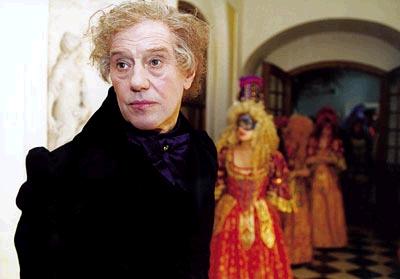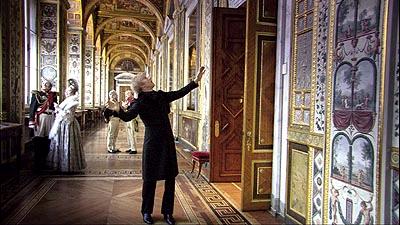Russian Ark


There are two ways to appreciate Russian Ark. The first is on a technical level, and the second is where one actually understands much of what is happening on screen. Unfortunately, the latter requires more than a passing knowledge of Russian history. Still, Russian Ark is an amazing technical feat and a logistical nightmare. The film consists of one sustained take. In other words, one camera filmed the entire movie, without any cuts or editing. This is even more amazing considering the movie takes place within the Hermitage museum, and has characters that span centuries. Essentially, the camera weaves slowly from room to room, with the players entering and exiting at their appointed time.
It all springs from the mind of director Aleksandr Sokurov (Elegy of a Voyage, Taurus). The entire movie is a walk through the Hermitage. It opens with the narrator, never more than a voice, seemingly waking up. He isn't sure where he is, or even when he is. All events take place from the perspective of the narrator. He meets a stranger (Sergei Dreiden, Marigolds in Flower, Window to Paris), a foreign diplomat who becomes the narrator's companion as they move from room to room. The two discuss a little bit of everything including history, politics, philosophy, and comment on much of what they see. Here is where the screenplay, by Boris Khaimsky, Anatoli Nikiforov, Svetlana Proskurina, and Sokurov, is liable to lose people and induce sleep. It is sometimes hard to follow if one doesn't know who most of the people are, or why they are important. A few recognizable names appear like Peter the Great, Catherine the Great, Nicholas II, and Anastasia, but otherwise it is a parade of unknowns.
Sokurov and his co-writers intend to convey the scope and grandeur of Russian history through the Hermitage and its various denizens throughout history. The selected eras and people show just how rich Russian culture is, and Sokurov is using this film to preserve it. He uses the narrator and the Stranger as guides through history; their conversation shedding light on what is happening around them. The real wonder is how Sokurov managed to orchestrate this entire movie. His camera wanders all over the museum, from grand ballrooms to cramped stairwells. One room may contain the Tsar and his family, then the camera moves into the next room, which has modern day tourists admiring the paintings. And some of the scenes are extraordinarily elaborate, requiring hundreds of extras. It is almost enough to sit back and gape at the opulent costumes and the fantastic pieces of art within the Hermitage, and even the Hermitage Museum itself.